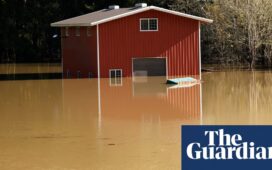Hurricane Milton made landfall as a category 3 hurricane on Wednesday night at around 8.30pm near Siesta Key in Florida. For about eight hours, the storm brought intense rainfall, flooding, tornadoes, storm surge and strong winds before moving off over the ocean just north of Cape Canaveral as a category 1 hurricane.
Some of the hardest-hit areas included Sarasota, Fort Myers, St Petersburg, St Lucie and other cities on the Gulf coast. Storm surge warnings were in effect along Florida’s east coast to Georgia’s Altamaha Sound.
Hurricane Milton caused destruction in towns in areas of the west coast, central and east coast of Florida.
Officials reported downed trees, storm surges, flooding, destroyed homes, damaged roads, downed power lines and damage to infrastructure, power and water systems and more.
As of Thursday at 11am, nine deaths had been reported, though search and rescue operations had scarcely begun.
Officials have warned that around 11 million people are at risk of flash and river flooding after some parts of the state received histroric amounts of rain. St Petersburg received around 18in, as well as localized flooding. St John’s county also saw “widespread flooding” that caused some roads to become impassable, officials said.
As search and rescue efforts continued on Thursday morning, early reports indicated about 125 homes were destroyed, primarily mobile homes in senior communities.
As of Thursday afternoon more than 3.3 million Florida residents were without power.
Tornadoes
Milton also “spun off a lot of tornadoes” in the impacted areas, Florida governor Ron DeSantis said on Thursday. “We anticipate there’s going to be confirmed casualties on the tornadoes, and that was all the way on the east coast of Florida,” he added.
Four fatalities have been reported in St Lucie county on Florida’s Atlantic coast as a result of several tornadoes that touched down there on Wednesday, officials said.
Several hours before Milton made landfall, the National Weather Service in Miami reported at least seven tornadoes and 53 tornado warnings were issued, 41 of which were issued by the weather service in Miami.
Videos and pictures posted online on Wednesday showed several spotted tornadoes growing in size as they moved across South Florida.
Storm surge
Although the powerful storm surge authorities predicted before Milton’s arrival may not have been as bad as projected, in some areas, such as parts of Sarasota county, a storm surge of 8 to 10ft was recorded.
On Thursday DeSantis also said that while the “storm was significant … thankfully this was not the worst case scenario”, adding that “the storm did weaken before landfall and the storm surge, as initially reported, has not been as significant overall as what was observed for Hurricane Helene.”
A storm surge, which is the rise in seawater level caused by a storm, can often be the greatest threat to life and property during a hurricane and lead to significant flooding.
The surge is caused primarily by a storm’s winds pushing water onshore. As a hurricane approaches a coast, the winds force ocean water up on to land, and atmospheric pressure from the storm also helps squeeze the water ashore. The shallower the continental shelf, the higher the threat of a dangerous surge, and surges become even more hazardous as they coincide with high tide.
Water is heavy – about 1,700lb (770kg) to a cubic yard (0.76 cubic meters) – and it can move fast in a surge, sweeping people to their deaths, throwing about boats and vehicles, and pulverising structures. The currents created by tides can also combine with the waves to severely erode beaches and coastal highways.
Six inches of fast-moving water is enough to knock over an adult, the National Hurricane Center says. In 2005, Hurricane Katrina caused storm surges of more than 25ft on the Mississippi coastline that killed as many as 1,500 people killed directly or indirectly.
Climate connection
Hurricane Milton was the second deadly hurricane in two weeks to hit the state of Florida, as hurricanes are becoming more intense and dangerous due to the climate crisis, caused primarily by the burning of fossil fuels, experts say.
According to the University Corporation for Atmospheric Research, sea level is predicted to rise between 29 and 82cm by the end of the century as a the sea continues to get warmer.
The research states that sea level rise will make storm surge flooding during hurricanes more devastating.
As greenhouse gases help trap heat in the atmosphere, they are also helping to supercharge the oceans with record-breaking temperatures.
In addition, hurricanes are getting more severe and intense as the heat in the Gulf of Mexico, where many of these storms develop, has been abnormally high. The extra heat acts as a sort of jet fuel for hurricanes, quickly turning them into major storms.
Researchers have found that since the 1970s, the number of storms escalating into category 4 or 5 hurricanes, with winds of at least 131mph (210km/h), has roughly doubled in the North Atlantic.
“If you look back in time, historically, storms intensified at a slower rate than they do now,” said Phil Klotzbach, a researcher at Colorado State University who specialises in hurricane forecasting.

